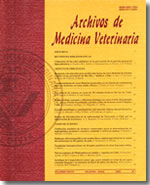A survey of benzimidazoleresistance in small strongyles (Cyathostominae) in the south of Chile
Main Article Content
Abstract
A survey of three stables in the Xth Region in Chile involving 100 horses was performed to evaluate the presence of benzimidazole(BZ)-resistance in the equine small strongyles. BZ-resistance was examined by two different methods, namely the faecal egg count reduction test (FECRT) and the egg hatch assay (EHA). Faecal samples were collected seven days before and seven days after treatment with fenbendazole to determine possible increase in the degree of resistance. The arithmetic means of the faecal egg counts were between 476.6 (S.D. ± 356.7) and 1095.3 (S.D. ± 755) epg before and between 137.1 (S.D. ± 171.8) and 725 (S.D. ± 481.3) epg after treatment. The FECRT indicated resistance in all studied farms with a faecal egg count reductions (FECR) of 27% (S.D. ± 33), 26.5% (S.D. ± 26.9) and 83.9% (S.D. ± 22.8). With the EHA BZresistance was found in one stable before (LD50 = 0.141 µg TBZ/ml) and in two stables after treatment with fenbendazole (LD50 = 0.149 and 0.158 µg TBZ/ml).

